EXAMPLE PROBLEMS USING ANGLE BISECTOR THEOREM
Angle Bisector Theorem :
The internal bisector of an angle of a triangle divides the opposite side internally in the ratio of the corresponding sides containing the angle.
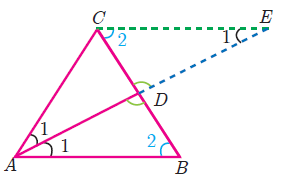
In ΔABC, AD is the internal bisector
AB/AC = BD/CD
Converse of Angle Bisector Theorem :
If a straight line through one vertex of a triangle divides the opposite side internally in the ratio of the other two sides, then the line bisects the angle internally at the vertex.
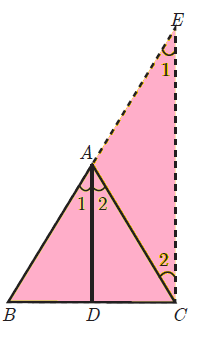
ABC is a triangle. AD divides BC in the ratio of the sides containing the angles <A to meet BC at D.
That is AB/AC = BD/DC
Example 1 :
In ΔABC, AD is the bisector of ∠A meeting side BC at D, if AB = 10 cm, AC = 14 cm and BC = 6 cm, find BD and DC
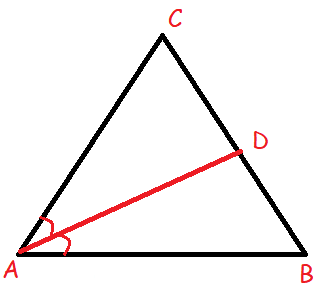
AB/AC = DB/CD
Let DB = x, then CD = 6 - x
10/14 = x/(6-x)
5/7 = x/(6-x)
5(6 - x) = 7x
30 - 5x = 7x
7x + 5x = 30
12x = 30
x = 30/12 = 5/2 = 2.5
BD = 2.5 cm and CD = 6 - 2.5 = 3.5 cm
Example 2 :
Check whether AD is bisector of ∠A of ΔABC in each of the following
(i) AB = 5 cm, AC = 10 cm, BD = 1.5 cm and CD = 3.5 cm.
Solution :
By angle bisector theorem :
AB/AC = DB/CD
5/10 = 1.5/3.5
1/2 = 3/7
Hence AD is not the bisector of <A.
(ii) AB = 4 cm, AC = 6 cm, BD = 1.6 cm and CD = 2.4 cm.
Solution :
By angle bisector theorem :
AB/AC = DB/CD
4/6 = 1.6/2.4
2/3 = 2/3
Hence AD is the bisector of <A.
Example 3 :
In figure <QPR = 90° , PS is its bisector. If ST ⊥ PR, prove that ST × (PQ + PR) = PQ × PR.
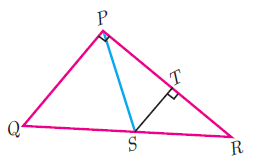
Solution :
Example 4 :
ABCD is a quadrilateral in which AB=AD, the bisector of <BAC and <CAD intersect the sides BC and CD at the points E and F respectively. Prove that EF BD .
Solution :
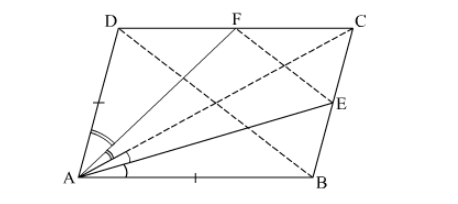
In triangle ABC, AE is the bisector of <BAC
AC/AB = CE/BE ----(1)
In triangle ACD, AF is the bisector <CAD
AC/AD = CF/FD
AC/AB = CF/FD ----(2)
(1) = (2)
CE/BE = CF/FD
Hence EF is parallel to BD.
Kindly mail your feedback to v4formath@gmail.com
We always appreciate your feedback.
©All rights reserved. onlinemath4all.com
Recent Articles
-
Digital SAT Math Problems and Solutions (Part - 150)
Apr 25, 25 11:46 AM
Digital SAT Math Problems and Solutions (Part - 150) -
AP Calculus AB Problems with Solutions (Part - 19)
Apr 24, 25 11:10 PM
AP Calculus AB Problems with Solutions (Part - 19) -
AP Calculus AB Problems with Solutions (Part - 18)
Apr 24, 25 11:06 PM
AP Calculus AB Problems with Solutions (Part - 18)
